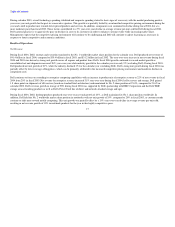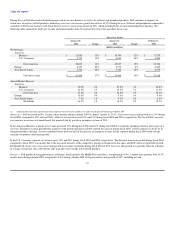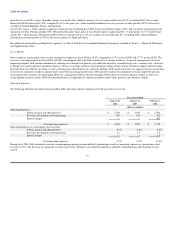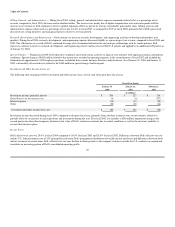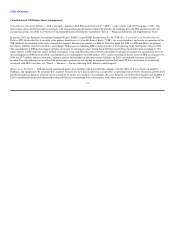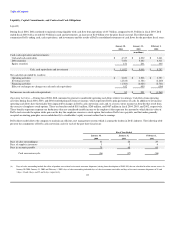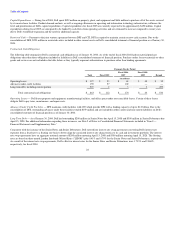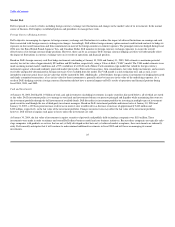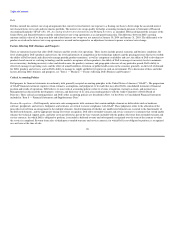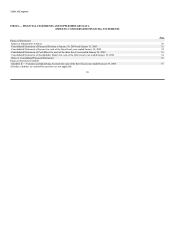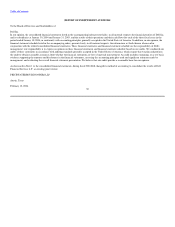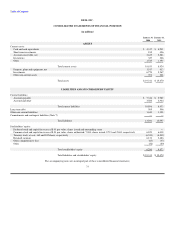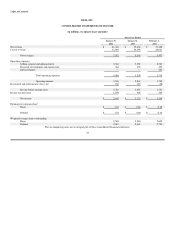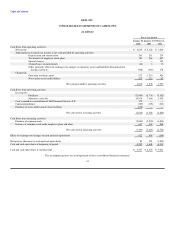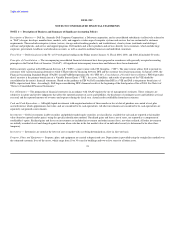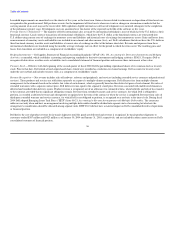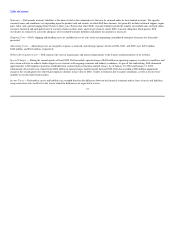Dell 2003 Annual Report Download - page 30
Download and view the complete annual report
Please find page 30 of the 2003 Dell annual report below. You can navigate through the pages in the report by either clicking on the pages listed below, or by using the keyword search tool below to find specific information within the annual report.
Table of Contents
Estimates that further impact revenue recognition relate primarily to customer sales returns and allowance for doubtful accounts. Both estimates are relatively
predictable based on historical experience. The primary factors affecting Dell's accrual for estimated customer returns include estimated return rates as well as
the number of units shipped that still have a right of return as of the balance sheet date. During recent fiscal years, customer returns as a percentage of gross
revenues have declined to approximately 1%. Factors affecting Dell's allowance for doubtful accounts include historical and anticipated customer default rates
of the various aging categories of accounts receivable. Each quarter, Dell reevaluates its estimates to assess the adequacy of its recorded accruals for customer
returns and allowance for doubtful accounts and adjusts the amounts as necessary.
Warranty — Dell records warranty liabilities at the time of sale for the estimated costs that may be incurred under its basic limited warranty. The specific
warranty terms and conditions vary depending upon the product sold and country in which Dell does business, but generally includes technical support, repair
parts, labor, and a period ranging from 90 days to three years. Factors that affect Dell's warranty liability include the number of installed units currently under
warranty, historical and anticipated rates of warranty claims on those units, and cost per claim to satisfy Dell's warranty obligation. The anticipated rate of
warranty claims is the primary factor impacting Dell's estimated warranty obligation. The other factors are relatively insignificant because the average
remaining aggregate warranty period of the covered installed base is approximately 20 months, repair parts are generally already in stock or available at pre-
determined prices, and labor rates are generally arranged at pre-established amounts with service providers. Warranty claims are relatively predictable based
on historical experience of failure rates. Each quarter, Dell reevaluates its estimates to assess the adequacy of its recorded warranty liabilities and adjusts the
amounts as necessary.
Income Taxes — Dell calculates a provision for income taxes using the asset and liability method, under which deferred tax assets and liabilities are
recognized by identifying the temporary differences arising from the different treatment of items for tax and accounting purposes. In determining the future
tax consequences of events that have been recognized in Dell's financial statements or tax returns, judgment is required. Differences between the anticipated
and actual outcomes of these future tax consequences could have a material impact on Dell's consolidated results of operations or financial position.
Recently Issued Accounting Pronouncements
In December 2003, the SEC issued SAB No. 104, Revenue Recognition, which supersedes SAB 101, Revenue Recognition in Financial Statements. The
adoption of SAB 104 did not have a material impact on Dell's consolidated results of operations or financial position. SAB 104 primarily rescinds the
accounting guidance contained in SAB 101 related to multiple-element revenue arrangements that was superseded as a result of the issuance of Emerging
Issues Task Force ("EITF") EITF 00-21, Accounting for Revenue Arrangements with Multiple Deliverables. While the wording of SAB 104 has changed to
reflect the issuance of EITF 00-21, the revenue recognition principles of SAB 101 remain largely unchanged by the issuance of SAB 104, which was effective
upon issuance.
In December 2003, the FASB issued FIN 46R, a revision to FIN 46. FIN 46R clarifies some of the provisions of FIN 46 and exempts certain entities from its
requirements. Entities that have adopted FIN 46 prior to this effective date can continue to apply the provisions of FIN 46 until the effective date of FIN 46R,
which is the first quarter of fiscal 2005 for Dell. Dell adopted FIN 46 at the beginning of the third quarter of fiscal 2004, which resulted in the consolidation of
DFS. See Note 6 of "Notes to Consolidated Financial Statements" included in "Item 8 — Financial Statements and Supplementary Data." FIN 46R is not
expected to have a material impact on Dell's consolidated results of operations or financial position.
27


